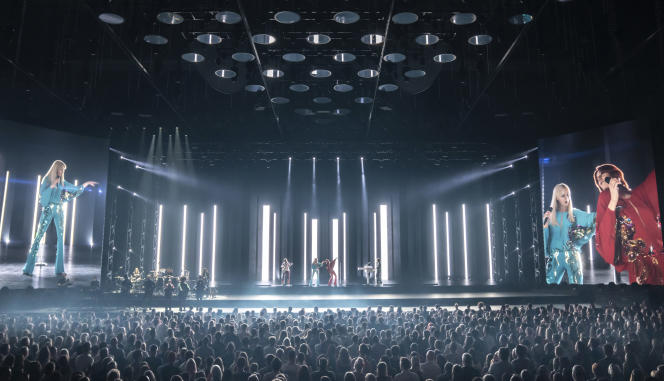At the end of the first song, as fans revel in the incredible technological feat of the start of the concert, Benny Andersson approaches the crowd and asks a dizzying question: “To be or not to be?” That is no longer the question. The member of ABBA who thus speaks with a small smile to the approximately 3,000 jubilant spectators is 33 years old, seems larger than life, but does not exist. It is a hologram. Or, more accurately, the three-dimensional projection of a computer-generated image, with the concert management insisting on not using the word “hologram.”
Whatever technology is used, it works. For an hour and a half, ABBA is on stage, dancing, singing, enthusing the crowd. But not just any ABBA: the four members of the Swedish group, now aged 72 to 77, appear with their outfits and their faces from 1979, when they were the sensation of the moment. It’s all there: the disco clothes, the unbeatable hits (Mamma Mia!, Gimme! Gimme! Gimme!, The Winner Takes It All…) and the irresistible urge to dance.
From the room, it is impossible to say that the four characters swaying on stage are not present. Between songs, they talk to the audience, take breaks, let the fans laugh at their jokes… Only the “close-ups” projected on the giant screens (along with other CGI) give the feeling of a video game, looking slightly too smooth to be real. But, between the spectacular play of lights, the loud decibels and simply the pleasure of reuniting with one of the most famous pop groups in history, the slight lag is quickly forgotten. “To be or not to be” is no longer a question: ABBA has brought concerts into the fourth dimension, the one that allows you to go back in time.
Juicy trade vein
“The last time we performed in London was in 1979,” Benny Andersson’s avatar reminds the crowd. This one is on the whole old enough to remember it. In the room, the gray hair claps, the baldness waddles, the parents have brought their adult children to take themselves for a few moments for dancing queens.
Debra Leigh and Orna Rowson were 12 and 16 when ABBA was at its peak. They were too young to have had the chance to see them in person. “It was the big concert I had missed,” enthuses Orna, won over by the performance. And already, she anticipates the future: “After ABBA, I’m sure that the next concerts of this kind will be the Beatles or Queen. A juicy commercial vein was born. With tickets that can exceed 150 euros, “packages” with hotel which are close to 400 euros for some, the glass of wine at the entrance to 8 euros, the four members of ABBA have enough to make their project profitable.
The case is of a phenomenal scale. The idea was born five years ago, initially around holograms, then a technology developed by the special effects company Industrial Light
A building was made especially for the occasion. The ABBA Arena, located in the former Olympic Park in London, all in wood and at right angles, is a great architectural success which probably houses a technological monster in its bowels. We find ourselves more than at a concert, somewhere between the three-dimensional cinema session (with two “sessions” per day on weekends) and the amusement park. In the short term, there is therefore no question of a tour, which would be too heavy to organize.
Feeling of watching a movie
The crowd was won over. The big hits have been insured. The new songs also work much less well with a crowd that simply wants to find a bubble from the end of the 1970s, as one tastes a candy that is too sweet. After the first bluffing minutes, the magic of the concert cracks slightly. A real music group is on stage to break up the feeling of watching a movie. But several songs are only accompanied by a cartoon, without even the “presence” of the four avatars.
ABBA chose to nod to the Eurovision Song Contest in 1974, when the group was suddenly revealed to the world with Waterloo. For this, he is content to project clips from the time. The feeling of leaving the concert and watching a documentary gradually creeps in. Unless it is a moment of truth, a deliberate way of reminding us that this breathtaking spectacle is not real.
At the end of the show, in an ultimate mise en abyme, the four “real” band members appear to greet the crowd. The wrinkles are back, the slightly arched backs. These are, however, once again, simple computer-generated images. The crowd doesn’t care: they applaud wildly. Of course, she knows perfectly well that she welcomes video images of people who are neither present nor real. But does reality still make sense?














